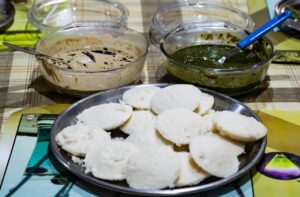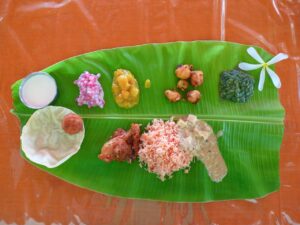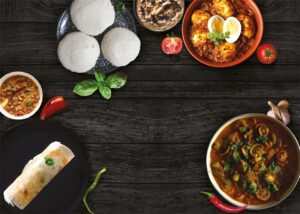THE TASTE OF SOUTH INDIA
South Indian cuisine is a culinary treasure trove that dazzles the senses with its vibrant flavors, aromatic spices, and diverse range of dishes. It’s a cuisine that marries tradition with innovation, resulting in a symphony of tastes that has captivated food enthusiasts worldwide. In this blog, we embark on a journey to unravel the intricacies of South Indian food, from its humble beginnings to its global popularity today.
A Melange of Flavors:
One of the defining characteristics of South Indian cuisine is its incredible diversity. Comprising the states of Andhra Pradesh, Karnataka, Kerala, Tamil Nadu, and Telangana, each region contributes its own unique flavors and ingredients. The liberal use of coconut, tamarind, curry leaves, and a variety of spices like mustard seeds, fenugreek, and red chilies form the foundation of many South Indian dishes.
- Dosa and Idli: Breakfast Champions:
No conversation about South Indian food is complete without mentioning dosa and idli. These beloved dishes are emblematic of the region’s culinary prowess. Dosa, a thin, crispy pancake made from fermented rice and lentil batter, comes in an array of flavors and sizes, from the classic masala dosa to the more exotic onion or cheese dosa. Idli, on the other hand, is a soft and fluffy steamed cake made from fermented rice and lentil batter, often served with coconut chutney and tangy sambar.
- Sambars and Rasams: Flavorful Accompaniments:
Sambhar and rasam are the heart and soul of South Indian meals. Sambhar, a lentil-based vegetable stew, is infused with a medley of spices and tamarind, offering a perfect balance of tanginess and warmth. Rasam, a tangy and aromatic soup, is typically served as a palate-cleansing appetizer or digestive aid. Both these dishes exemplify the South Indian knack for blending contrasting flavors into a harmonious whole.
- Coconut’s Culinary Charm:
Coconut is an essential ingredient in South Indian cooking, adding richness and depth to a myriad of dishes. Coconut-based chutneys, gravies, and curries are common across the region. Coconut milk, extracted from the flesh of the fruit, lends creaminess to many curries, while freshly grated coconut enhances the texture and taste of various accompaniments.
- Seafood Splendor of Kerala:
Kerala, with its long coastline, offers a seafood extravaganza that’s hard to match. The state’s cuisine features delectable fish curries, prawn delicacies, and crab preparations, all infused with the distinct flavors of coconut and spices. Meen Pollichathu, a banana leaf-wrapped fish preparation, and Malabar Prawn Curry are just a couple of examples that showcase Kerala’s mastery over seafood.
- Traditional Sweets and Snacks:

South Indian desserts and snacks are a league of their own. Murukku, crispy rice and lentil spirals, and Mysore pak, a rich gram flour and ghee fudge, are popular snacks that accompany evening tea. When it comes to sweets, the array is extensive – from the syrup-soaked Gulab Jamun-inspired Mysore Pak to the jaggery-infused Payasam, every sweet tells a story of tradition and innovation.
Savoring the Irresistible Taste of South Indian Food
South Indian cuisine is renowned not just for its rich cultural heritage, but also for its distinctive and unforgettable taste. With its array of spices, aromatic herbs, and unique cooking techniques, South Indian food offers a culinary experience that delights the palate and leaves an indelible impression. In this article, we delve into the exquisite taste of South Indian cuisine and explore the elements that make it a culinary sensation.
- A Symphony of Flavors:
At the heart of South Indian food lies a symphony of flavors that dance harmoniously on the taste buds. The use of spices such as mustard seeds, cumin, fenugreek, and curry leaves infuses dishes with a burst of aroma and depth. These spices, combined with tamarind, coconut, and chilies, create a medley of sweet, tangy, spicy, and savory sensations that evoke both comfort and excitement.
Balance and Harmony:
South Indian cuisine is a masterclass in achieving balance and harmony. Take, for instance, the classic dish of dosa with coconut chutney and sambar. The crispy dosa is the perfect foil for the creamy coconut chutney, while the tangy and spicy sambar bridges the gap between the two. This delicate equilibrium of textures and flavors is a hallmark of South Indian cooking, resulting in dishes that are not only delicious but also satisfying.
- The Magic of Fermentation:
Fermentation is a key technique in South Indian cooking that contributes to the unique taste of many dishes. The fermentation process enhances the flavors, making them more pronounced and complex. The idli, with its soft and pillowy texture, owes its distinct taste to the fermentation of rice and lentil batter. Similarly, the tangy twang of dosa and the slight sourness of appam can be attributed to this age-old practice.
- Aromas That Mesmerize:
It’s impossible to talk about South Indian food without mentioning the captivating aromas that waft from the kitchen to the dining table. The tempering of spices in hot oil, known as “tadka” or “tarka,” is a technique that releases the essential oils of the spices, infusing the dish with an irresistible fragrance. This aromatic touch not only enhances the taste but also makes the entire dining experience more inviting.
- Local and Seasonal Ingredients: The taste of South Indian cuisine is deeply connected to the use of local and seasonal ingredients. The availability of fresh vegetables, fruits, and seafood influences the composition of dishes, ensuring that every bite is packed with flavor and vitality. From the coastal delights of Kerala to the spice-laden dishes of Andhra Pradesh, each region’s cuisine reflects the bounties of its environment.

South Indian cuisine is renowned for its unique flavors, diverse ingredients, and regional specialties. Here are some of the key features and specialties that make South Indian food distinct:
- Rice-Based Dishes: South Indian cuisine predominantly uses rice as a staple food. Rice is consumed in various forms, such as steamed rice, idli (steamed rice cakes), dosa (rice crepes), and biryani (fragrant rice dish).
- Coconut: Coconut is a prominent ingredient in South Indian cooking. Coconut milk, grated coconut, and coconut oil are used in a wide range of dishes, providing a rich, creamy texture and a hint of sweetness.
- Spices and Heat: South Indian cuisine is known for its spicy and flavorful dishes. Common spices include mustard seeds, curry leaves, red and green chilies, black pepper, and turmeric. These spices add heat, aroma, and complexity to the food.
- Vegetarian Emphasis: South Indian cuisine is known for its extensive array of vegetarian dishes. Staples like sambar (a lentil-based vegetable stew), rasam (spicy tamarind soup), and various vegetable curries are popular choices.

- Fermented Foods: Fermentation is a common technique used in South Indian cooking. Dishes like dosa and idli are made from fermented rice and lentil batter, which results in a unique sourdough-like flavor and light, airy texture.
- Tamarind: Tamarind is frequently used to add tanginess and depth of flavor to South Indian dishes. Tamarind-based sauces and chutneys are common accompaniments.
- Varied Cuisine Across States: South India comprises several states, each with its own distinctive cuisine. For example, Andhra cuisine is known for its spicy dishes, Kerala cuisine features coconut-based preparations, Karnataka offers a mix of flavors, and Tamil Nadu showcases a balance of spicy and tangy flavors.
- Seafood Delicacies: Coastal regions of South India, like Kerala and Tamil Nadu, are renowned for their seafood dishes. Fish, prawns, and other seafood are often prepared with aromatic spices and coconut milk.
- Diverse Snacks: South India is famous for its wide range of snacks, including vada (fried lentil fritters), pakoras, bhajis, and bajjis, which are often served with chutneys or sambar.
- Sweets and Desserts: South Indian desserts often incorporate ingredients like jaggery, rice flour, and lentils. Popular sweets include payasam (rice or vermicelli pudding), kesari (semolina dessert), and various types of laddus.
- Use of Banana Leaves: Traditional South Indian meals are often served on banana leaves, which not only add an earthy aroma but also have natural antimicrobial properties.
- Health Benefits: South Indian cuisine is often considered healthy due to its use of rice, lentils, and vegetables. Dishes like sambar and rasam are rich in nutrients and are believed to aid digestion.
In summary, South Indian cuisine is a vibrant and diverse culinary tradition known for its use of rice, coconut, spices, and unique cooking techniques. Whether you’re a fan of vegetarian fare, seafood delicacies, or flavorful snacks, South Indian food offers a wide range of options to tantalize your taste buds.
Certainly, here are some more aspects that make South Indian cuisine special:
- Breakfast Variety: South India is known for its extensive breakfast menu. In addition to dosa and idli, there are dishes like uttapam (thick rice pancakes), pongal (a rice and lentil porridge), and upma (savory semolina porridge) that are popular morning choices.
- Pickles and Chutneys: South Indian cuisine features a wide range of pickles and chutneys made from various ingredients like mango, tamarind, coconut, and even garlic. These condiments add a burst of flavor to meals.
- Regional Variations: Each state in South India has its own regional specialties. For example, Chettinad cuisine from Tamil Nadu is known for its fiery and aromatic dishes, while Malabar cuisine from Kerala is famous for its use of spices like cardamom and cloves.
- Tiffin: Tiffin refers to light meals or snacks and is an integral part of South Indian food culture. It includes dishes like paniyaram (rice and lentil dumplings), appam (rice pancakes), and bonda (deep-fried snacks).
- Banana and Plantain: South India has a deep-rooted tradition of using bananas and plantains in various forms. They are often used in dishes like banana chips, banana leaf-wrapped snacks, and plantain-based curries.
- Special Festive Foods: South Indian cuisine boasts a rich array of festive and ceremonial dishes prepared during occasions like weddings and festivals. Examples include avial (a mixed vegetable dish) and adai (a thick rice and lentil pancake) in Tamil Nadu.
- Healthy Ingredients: South Indian cuisine often incorporates healthful ingredients like curry leaves, which are believed to have medicinal properties, and a variety of lentils (dal), which are a good source of protein.
- Coffee Culture: South India has a strong coffee culture, especially in states like Karnataka and Tamil Nadu. Filter coffee, made from dark roasted coffee beans and chicory, is a popular beverage served with frothy milk.
- Balance of Flavors: South Indian cooking often emphasizes the balance of flavors. Dishes typically combine spicy, tangy, savory, and sometimes sweet elements to create a harmonious taste profile.
- Family and Community Meals: Sharing meals with family and community is a cherished tradition in South India. Large family gatherings and community feasts are common during festivals and special occasions.
- Use of Traditional Cookware: Traditional South Indian cooking often involves the use of unique utensils like the “uruli” (a wide, shallow brass vessel) and “kal chatti” (stone pot), which are believed to enhance the taste of certain dishes.
- Heritage of Vegetarianism: South India has a long history of vegetarianism, with many people following vegetarian diets due to cultural and religious reasons. This has led to the development of a rich and diverse vegetarian culinary tradition.
South Indian cuisine’s rich tapestry of flavors, regional variations, and diverse ingredients make it a culinary experience that continues to captivate food enthusiasts worldwide. Whether you’re savoring a traditional meal or exploring modern interpretations, South Indian food offers something for everyone to enjoy.
-
Table of Contents
- Introduction to South Indian Cuisine
- Overview of South Indian Food
- Regional Variations
- Key Ingredients
- Rice and Rice-based Dishes
- Coconut
- Spices and Seasonings
- Lentils (Dal)
- Breakfast Delights
- Idli
- Dosa
- Upma
- Pongal
- Vada
- Main Course
- South Indian Curries
- Sambar
- Rasam
- Avial
- Biryani and Pulao
- Accompaniments
- Chutneys
- Pickles
- Papad
- Raita
- Coconut Chutney
- Introduction to South Indian Cuisine
